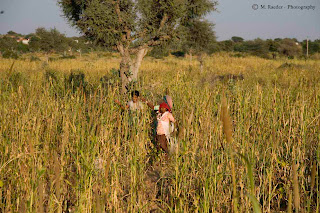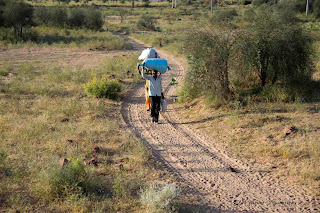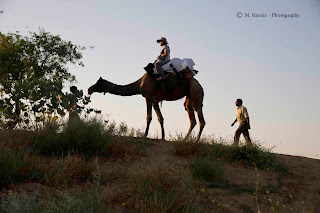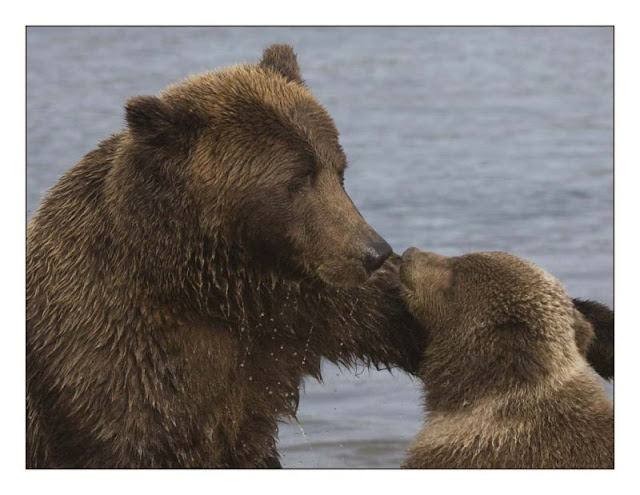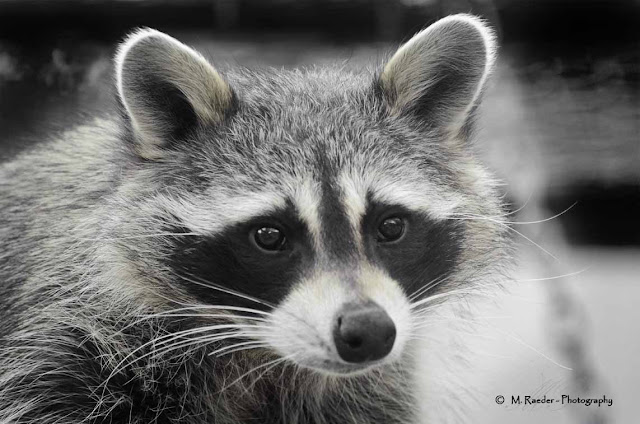Camel Ride at Sunset
We have traveled deep into Rajasthan and we are in camel country. It is dry and hot and the desert is all around us.
At the end of the afternoon, we are invited to a camel ride to see the sunset. Two camels await us outside the reception area since Ashim decided to walk. On command, the camels ‘fold their legs under their bodies’ by first going onto their knees, then bringing their hind down before lowering their front. We are being helped up into a sort of saddle, a very well cushioned affair, and the camels stand up in the same stepwise way – rocking us frontward and backwards as we ascend to the heights of a full standing camel over-towering everyone around us. And off we go!
 We each have our camel driver, 2 young boys of 9 and 10 years of age. My camel driver is Monsoor who speaks “little English, not big English”. The boys handle the camels skillfully trying to prevent them from stopping and grabbing a mouthful of leaves from the trees. We walk through desert farmland where crops have been harvested and now the stalks are drying to be gathered for fire woods.
We each have our camel driver, 2 young boys of 9 and 10 years of age. My camel driver is Monsoor who speaks “little English, not big English”. The boys handle the camels skillfully trying to prevent them from stopping and grabbing a mouthful of leaves from the trees. We walk through desert farmland where crops have been harvested and now the stalks are drying to be gathered for fire woods.
Meggi
We have traveled deep into Rajasthan and we are in camel country. It is dry and hot and the desert is all around us.
By mid afternoon, we reach the Camp Thar Desert
At the end of the afternoon, we are invited to a camel ride to see the sunset. Two camels await us outside the reception area since Ashim decided to walk. On command, the camels ‘fold their legs under their bodies’ by first going onto their knees, then bringing their hind down before lowering their front. We are being helped up into a sort of saddle, a very well cushioned affair, and the camels stand up in the same stepwise way – rocking us frontward and backwards as we ascend to the heights of a full standing camel over-towering everyone around us. And off we go!
 We each have our camel driver, 2 young boys of 9 and 10 years of age. My camel driver is Monsoor who speaks “little English, not big English”. The boys handle the camels skillfully trying to prevent them from stopping and grabbing a mouthful of leaves from the trees. We walk through desert farmland where crops have been harvested and now the stalks are drying to be gathered for fire woods.
We each have our camel driver, 2 young boys of 9 and 10 years of age. My camel driver is Monsoor who speaks “little English, not big English”. The boys handle the camels skillfully trying to prevent them from stopping and grabbing a mouthful of leaves from the trees. We walk through desert farmland where crops have been harvested and now the stalks are drying to be gathered for fire woods.The path we walk on – or better the camels walk on – is sandy. The Thar Desert is a hot and dry place and supports only vegetation adapted to sandy grounds. But it appears that the farmers here work the land to feed their families. We pass by little hamlets where a few families have built their modest homes and where livestock from cows and goats to peacocks live in harmony with the people.
After an hour’s walk we reach a hill side and our camels reluctantly climb up to a sand dune their broad hoofs sinking into the sand and sometimes sliding backwards.
As we de-mount, Lynda’s camel flops down on its side as if to tell us how exhausted it is!!
... and we all sit down to rest.
Our walk was perfectly timed as the sun is setting the sky turned yellow and red with the last rays and our camels silhouette beautifully against the darkening sky.
Night has fallen fast and as we descend the hills, it becomes dark but our sure-footed beasts carry us back to camp in a steady walk and we marvel at the stars above. With no lights around us in the desert, we see the Milky Way and many star constellations shining down on us. It is peaceful and the world is at rest. But as the warm lights of camp greet us, men and beast are happy to be home.
Til next time,Meggi

